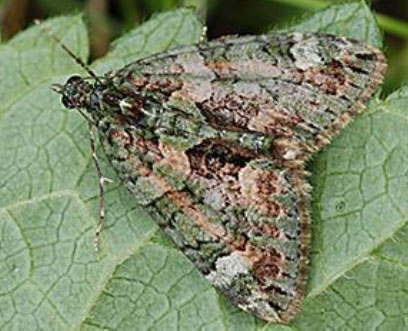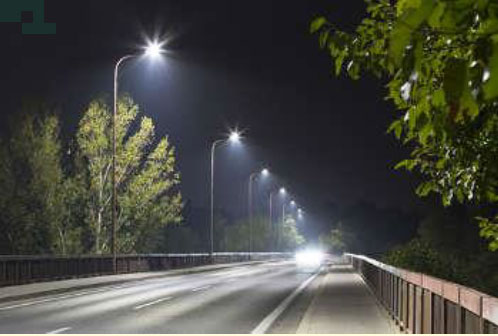UK Centre for Hydrology and Ecology
Aug 2021

Street lighting disrupts pollinating moths
Street lights change the natural behaviour of moths and disrupt nocturnal pollination, new research shows.
The study, led by a team from Newcastle University, the Centre for Ecology & Hydrology and Butterfly Conservation, revealed a shift in moth activity in street-lit areas from vegetation level to lamp-post height and the impact this is having on their ability to pollinate flowers.
The role played by moths in plant pollination has been largely overlooked as previous studies have focused on daytime pollinators, such as bees. Now the team says more research is needed to understand the effect of street lighting on moth populations and their importance as pollinators.
The new study, published in the journal Global Change Biology, was led by PhD student Callum Macgregor. He said, “We all know moths are attracted to light – some people might grumble about finding them flitting around in the bathroom or banging against the window.
“Where there are street lights, our research indicates that the moths are being attracted upwards, away from the fields and hedgerows. This is likely to cause disruption of night-time pollination by moths, which could be serious for the flowers which rely upon moths for pollination, and of course there could be negative effects on the moths themselves as well.”
“Where there are street lights, our research indicates that the moths are being attracted upwards, away from the fields and hedgerows.” Callum Macgregor
Dr Michael Pocock of the Centre for Ecology & Hydrology, a co-author of the paper, said, “Street lighting at night is important for road safety and people’s security but our research is just the latest piece of evidence showing the unintended negative effects of street lighting on wildlife.
“It indicates that the blanket of street lighting that covers many countries not only affects moths but has effects which cascade across ecosystems.”
Like the more well-known pollinators, bees and butterflies, moth populations in the UK and Europe are in severe long-term decline, with artificial night lighting one potential cause. It is only recently, however, that the crucial role played by moths in plant pollination has been fully appreciated.
Capturing and counting moths in lit and unlit areas of farmland in Oxfordshire, the team found that moth abundance at ground level was halved in lit areas but flight activity at the height of the street light was nearly doubled. Species richness was also reduced at ground level, with 25% fewer species in lit areas compared to those areas where there was no street lighting.
Analysing the presence of pollen on the captured moths, the team found that 1 in 4 of the insects were carrying pollen (from at least 28 plant species) so the halving of moth activity at ground level at lit sites could be affecting nocturnal pollination.
Co-author Dr Darren Evans from Newcastle University, said, “There is a great deal of concern at the moment about our falling pollinator populations and the knock-on effect on plant pollination. Our research suggests that it’s a process that is being damaged on two fronts – night and day – and together the impact could be significant.”
Richard Fox, from partner organisation Butterfly Conservation and also a co-author, added, “Moths are an important part of the UK’s biodiversity, as pollinators of wild flowers and as food for many birds and predators. However, the total abundance of moths in Britain has decreased by over a quarter since the 1960s with likely knock-on effects on many other organisms. The role of artificial light in causing moth declines remains unclear, but this new research indicates effects not just on moths but on the whole ecosystem.”
The impact of street lighting on our ecosystem
Globally, there are now an estimated 300 million street lights. The current study focused on the high pressure sodium street lamp found on most streets in Britain but the team is now investigating the impact of replacing these with LED lights. They recommend that, before replacement road lights are widely introduced, policy-makers should investigate their wider impact on natural systems.
The research was funded by the Natural Environment Research Council. The study is available as an open access paper.
Additional information
Newcastle University issued a press release for this story. Callum also wrote a blog post on the research for The Conversation.
Full paper reference: The dark side of street lighting: impacts on moths and the disruption of nocturnal pollination. Callum Macgregor, Darren Evans, Richard Fox and Michael Pocock. Global Change Biology 2016. doi: 10.1111/gcb.13371
Staff page of Dr Michael Pocock, Centre for Ecology & Hydrology
Centre for Ecology & Hydrology
Public Health England issues LED street lighting warning
03/04/2018
Public Health England has warned that high levels of blue light in LED street lighting can be uncomfortable and are ‘known to cause damage to the retina’.
The executive agency of the Department of Health also suggested that ‘daylight-running lights on cars’ can mean that older drivers ‘will be dazzled by oncoming vehicles with the risk that they may not see hazards until too late’ – a problem exacerbated by fog.
LED street lights have been used to replace older forms of street lighting across the UK as they are much cheaper to run, easier to control and can have less light dispersal.
However John O’Hagan of Public Health England warned that social and health factors should be considered, as well as financial.
‘Local authorities have been replacing mercury and sodium street lights with LEDs. If this is done purely on the basis of energy efficiency and cost, it is possible to end up with installations that may not be fit for purpose,’ he wrote in the chief medical officer’s annual report.

‘Some streetlight luminaires have LED sources that can be seen physically projecting below the luminaire, becoming a glare source or light pollution. The light spectrum may be enriched in the blue, which may be beneficial for keeping drivers alert, but many people will find the light uncomfortable. High levels of blue light are known to cause damage to the retina in the eye. This only tends to be a problem for blue LEDs and not for white-light LED sources containing a blue LED and a yellow phosphor.’
He pointed out that LEDs can be provided in a range of colour temperatures and that ‘warmer colours are likely to be more appropriate for populated areas’.
Mr O’Hagan said: ‘Some of the LED sources assessed by Public Health England and others vary in illuminance at a frequency of 100 hertz. At the extreme, the LEDs switch on and off 100 times per second. This is of concern for a number of reasons.’
In such circumstances ‘rotating machinery, which could include the blades on a food mixer, may appear to be stationary if the rotation rate matches the modulation rate or is a multiple of it’.
He added this frequency can also result in headaches, migraines and feelings of malaise in those sensitive to this light modulation.
“There are number things that should be considered,” said Marshall.
(1) Radiation action spectra are not absolutes and the wave breaks between the UV and visible are not in themselves absolutes. Action spectra tend to be Gaussian.
(2) While people accept the potential hazards of ultraviolet and protect eyes with specific filtration in for example in intraocular lenses there has never been a clinical trial demonstrating efficacy. I.e. there is no evidence-based medicine. However, few if any ophthalmologist will put a lens in without a UV block. But remember no evidence of efficacy.
(3) Short wavelength blue light is more hazardous than any other portion of the visible spectrum and is taken into account with special calculations in all the world’s laser/light protection documents. The so-called blue light hazard peaks at 441 nm. This initiates two forms of light damage based on two different absorption systems. Type I is very Low level exposures over very long periods depend upon absorption within the photoreceptor cells and type II is short exposures dependent upon absorption in the retinal pigment epithelium. There is no doubt among safety experts under certain circumstances short wavelength blue is hazardous to the retina.
(4) Blue light is attenuated in the normal eye by progressively accumulating yellow pigment in the cornea and more importantly the lens and the luteal pigment (peak absorption 448 nm, i.e. proximal to the peak of the blue light hazard) in the macular. Remember also there are no ” blue photoreceptor cells” in the foveola. From an evolutionary standpoint in terms of vision short wavelength blue is not a requirement for good visual acuity, remember Fovial tritanopia!
Climate News
LED streetlights decimating UK insect population, study finds
LED lights have a knock-on effect to other species, including hedgehogs, and songbirds
Samuel Webb
Whiter outdoor LED lights are harmful to insect populations
(Douglas Boyes)
LED streetlights are decimating the UK insect population, a study has found
The ‘eco-friendly’ lights are even more harmful to insect populations than the traditional sodium bulbs they are replacing, researchers from the UK Centre for Ecology & Hydrology (UKCEH) found.
The Independent
LED lights in your house can cause irreversible damage to the eyes, French health authority warns
,
